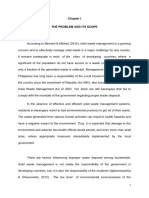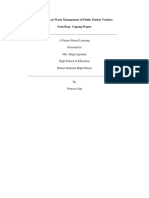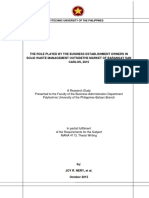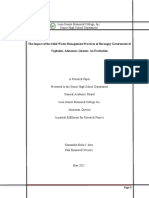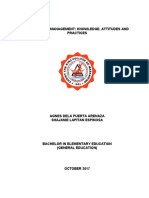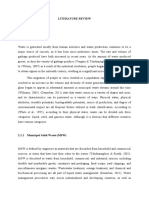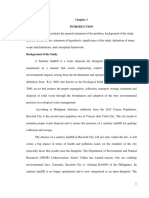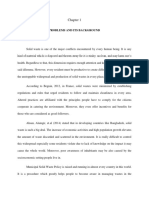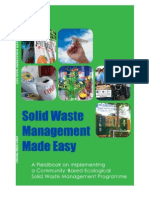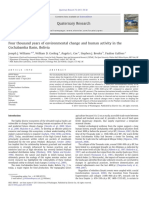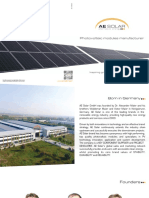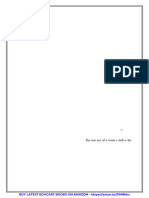Thesis Proposal (Final)
Thesis Proposal (Final)
Uploaded by
Geneva KatugCopyright:
Available Formats
Thesis Proposal (Final)
Thesis Proposal (Final)
Uploaded by
Geneva KatugOriginal Title
Copyright
Available Formats
Share this document
Did you find this document useful?
Is this content inappropriate?
Copyright:
Available Formats
Thesis Proposal (Final)
Thesis Proposal (Final)
Uploaded by
Geneva KatugCopyright:
Available Formats
Chapter I Problem and Its setting Introduction
In the light of the worlds chapter of today, Waste has been playing a very large role in polluting the environment. Waste is always included in the daily routine of all individuals in the world. With Urbanization, economic development and the Rapid Increase of population Peoples lifestyle have changed throughout the generation giving additional garbage which supplies more to organic pollution. There is a great deal of trash being disposed in different houses, what more for an entire country? Hundreds of tons of household wastes are being generated daily by each house contributing to the massive environmental problem the world is facing. Republic Act No. 9003 also known as the Ecological Solid Waste Management Act of 2000, it is hereby declared the policy of the state to adopt a systematic, comprehensive and ecological solid waste management program. This act intends to successfully reduce the amount of Garbage while putting up competent recycling based-management system in the country. This law calls for the adoption of the best environmental practices in ecological waste management and explicitly excludes waste incineration as an ecological option. (http://www.chanrobles.com/legal8.html) It is then stated in the Section 10 of this act that Pursuant to the relevant provisions of R. A. No. 7160, otherwise known as the Local government code, the LGUs shall be primarily responsible for the implementation and enforcement of the provisions of this Act within their respective jurisdictions. Our local government units (LGUs) are
responsible for enforcing the law. Government agencies on the national level are required to support LGUs in carrying out this responsibility. LGUs are thus required to draw up a solid waste management plan; Local government units are mandated to implement proper solid waste management. Consequently the City of General Santos agreed to pass the City Ordinance No. 12, series of 2008, also known as the General Santos City Ecological Solid Waste Management Ordinance of 2008. The Goals, Provisions and objectives are very much alike with the Republic Act 9003. This was an effort to create awareness among the public on the importance of environmental protection and preservation. The barangay shall be responsible for the collection, segregation, recycling of biodegradable, recyclable, compostable and reusable wastes.
(http://spgensantos.ph/2011/10/ordinance-12-series-of-2008/#). In line with this, Barangay Labangal has adopted this ordinance to address the problems regarding the issues in Waste disposal in their area. The main concern of this study is to verify how the committee implements the program and how effective the program is in solving the problems it meets and how they furnish answers to solve the problems.
Statement of the Problem Specifically, this study will find answers to the following questions: 1.) Are the residents of Doa Soledad Subdivision aware of the Solid Waste Management Program of Barangay Labangal? 2.) What is the Level of awareness of the residents of Doa Soledad Subdivision towards the Solid waste management program of Barangay Labangal? 3.) Who are the members of the Solid waste Management Program of Barangay Labangal? 4.) Are the programs and activities in implementing Solid Waste management program in the barangay effective? Assumptions of this study: 1.) Yes, the residents are aware of this Solid Waste Management Program of the Barangay. 2.) The residents are very aware of the said program. 3.) The members of the committee 4.) Yes the programs and activities being implemented are effective enough to answer the problem in waste.
Significance of the study As mentioned, the goal of this study is to know the effectivity of the program, the projects and activities engaged by the committee and the committee in charge in dealing with the agenda as perceived by the residents of Dona Soledad Subdivision. This study is important it is because the country is now being overwhelmed with massive land of wastes and high risk of health problems are also rising due to this problem, diseases such as the outbreak of Dengue, diarrhea, Malaria and other diseases. It will give a background view of what the government do to address this pressing issue about garbage. This will give a vision if the residents are really knowledgeable about the said program and if they participated in the efficacious implementation of the program in addressing the glitches related to Solid Waste Management in the field area. It will also help others to be conversant on how the program has been working in the barangay. This study will give a better understanding to the people about how the program works and how it affects the lives of the people. This study will also help future researchers in their study where it will serve as their reference for those who are willing to conduct research about Solid Waste Management.
Scope and Limitation of the Study The researcher comes across and limits the study to the perception of the Residents of Dona Soledad Subdivision within the Solid Waste Management Program being adopted by the officials of Barangay Labangal. The research is concentrated on the awareness of the residents, the effectiveness of the program and the mechanisms used by the committee to have a successful implementation of the program. The researcher will interview different residents in Dona Soledad Subdivision. This research will be conducted in different areas of Dona Soledad Subdivision, for these residents are the ones affected by the implementation of this program. Definition of terms 1.) Waste Conceptually, these are materials that are not prime products (that is products produced for the market) for which the initial user has no further use in terms of his/her own purposes of production, transformation or consumption, and of which he/she wants to dispose.
(http://en.wikipedia.org/wiki/Waste#Education_and_awareness) Operationally refers to the household and commercial garbage of Barangay Labangal. 2.) Solid Waste Management- Conceptually, it is a systematic control of generation, collection, storage, transport, source separation, processing, treatment, recovery, and disposal of solid waste.
(http://www.businessdictionary.com/definition/solid-wastemanagement.html#ixzz25F0Eddhn)
3.) Program- Conceptually, it is a plan of action aimed at accomplishing a clear business objective, with details on what work is to be done, by whom, when, and what means or resources will be used.(
http://www.businessdictionary.com/definition/program.html)
4.) Effectiveness- Conceptually, it is the capability of producing a desired result. When something is deemed effective, it means it has an intended or expected outcome, or produces a deep, vivid impression.
(http://en.wikipedia.org/wiki/Wikipedia:Wikipedia_is_not_a_dictionary)
5.) Implementation- Conceptually, Implementation is the realization of an application, or execution of a plan, idea, model, design, specification, standard, algorithm, or policy. (http://en.wikipedia.org/wiki/Wikipedia:Implementation)
6.) Committee- Conceptually, it is a group of people appointed or chosen to perform a function on behalf of a larger group. (Microsoft Encarta 2009. 1993-2008 Microsoft Corporation.)
7.) Residents- Conceptually, these are people who maintains residency (domicile) in a given place. (http://en.wikipedia.org/wiki/Resident)
Conceptual Framework Perception is the main thought of this Research study. Perception refers to interpretation of what we take in through our senses. Concepts are sometimes seen as foundations of communication which are abstracted from perceptions and are used to convey and transmit information. Such study like this depends on the answer of the respondents, whose principles vary from each other because they think differently in such events. Perception is a process of the consciousness of an object. It is one of the means of valid knowledge in the world and consists in an inseparable relation of the perceptive consciousness with its content. In perception there is first the illumination of the mind by the consciousness, then the activation of the senses by the mind, and thirdly the contact of the senses with the external object. The presence of the current of an unceasing linking up these different elements contributing to perception makes perception possible. The mind is not something static, passive, and merely receptive. It takes an active part in perception both by reason of its activity and the nature of that activity as caused by its latent tendencies. http://swami-
krishnananda.org/phil/Philosophy_of_Life.pdf) Social perception is a part of perception that allows people to understand the individual and the groups of their social world, and thus an element of Social cognition. This Social Perception is interlinked with self-perceptions. Both are influenced by selfmotives. Society has the desire to achieve beneficial outcomes for the self and to maintain a positive self-image, both for personal physic benefits and because we know
that others perceive us as well. It is human nature to want to create a good impression on others, almost as if self-perceptions are others social perceptions.
(http://www.wikipedia.com/socialperception.html) The resulting impressions that we form are based off of information available in the environment, our previous attitudes about relevant stimuli, and our current mood. Humans tend to operate under certain biases when forming impression of other individuals. (Marques, Abrams and Serodio, 2001) The conceptual paradigm on the next page shows the movement of this research study. The Residents are the main respondents of this study, their perception about this Ordinance 12 of 2008 also known as the Ecological Solid Waste Management of General Santos City being adopted by Barangay Labangal and the projects and activities undertaken by the Committee on implementing the program will verify if the Program is effective or ineffective.
Conceptual Diagram
Figure 1
Residents
Perception
Ordinance 12 of 2008 Committee Projects and Activities Ecological Solid Waste Management of General Santos City
Effective or Ineffective
Figure 1 shows the flow of this research study. The respondents will determine whether the ordinance and the projects and activities undertaken by the Committee on Solid Waste Management program is effective or ineffective.
Chapter II Methodology This Chapter presents the research design, research locale and respondents, data gathering procedure, research instrument, and the treatment and analysis of data that will be employed during the conduct of this study. Research Design The proposed study will employ a Quantitative type of research. Quantitative research is used widely in Social Sciences most specifically in Sociology and Political Science. This proposal will use a descriptive survey method also known as Statistical Method, where it analyses data in answering questions about the program being studied. It will determine the level of awareness of the residents of Doa Soledad Subdivision towards Solid Waste Management Program of Barangay Labangal, The effectiveness of the Program itself and the mechanisms being employed by the committee behind the implementation of the program. It will interpret the data that will be gathered concerning the perception of the Residents of Doa Soledad Subdivision towards the program on the assorted questions related to the matter. Research Locale and Respondents The research locale of this study centres on the Residents of Doa Soledad Subdivision, Barangay Labangal General Santos City. This research will be directed among the Selected Phases in Doa Soledad Subdivision. This study is conducted to
measure the consciousness of the residents towards the program, effectiveness, capability of the program in answering the environmental problem in the area and how the perception of the residents influences their involvement to the program. Barangay Labangal was a part of the Municipality of Buayan, now known as General Santos City. It was created in July 08, 1968. Barangay Labangal is a coastal community located along the Sarangani Bay. Barangay Apopong on the South bound, on the North by Barangay Calumpang on the west by Sarangani Bay and on the East by Dadiangas. Its total population as of 2010 is 77,694 and the total land area of Barangay Labangal is estimated at 2,500 hectares. (Barangaylabangal-profile.pdf) Barangay Labangal as of today still emerges as the most progressive and the biggest contributory income earner of the city. With the presence of the most modern government seaport in the country today and two privately owned wharf. The presence of big establishment and canning industries also provide a contributory factor toward the achievement of the area. In its way to development, issues regarding waste production in the barangay arises. Doa Soledad Subdivision has 8 phases. I will be limiting my study into 4 phases specifically, Phase 4 being the largest phase in Doa Soledad Subdivision, next is Phase 2B, then Phase 3A and Phase 6. Data Gathering Procedure The researcher will gather the data by using a well- equipped and primed questionnaires. The researcher will personally distribute the questionnaires to the residents and personally collect it after they answer all the questions. The researcher will tally the results in a master sheet after it has been collected and will get the results.
Instruments The instrument that the researcher will use is a questionnaire. The questionnaire will involve different parts. The first part consists of the respondents personal background. It involves questions regarding their name, age, gender, address, civil status and religion. The next part of the questionnaire will contain the level of awareness of respondents towards the Program and the Committee asking if the respondents are in the know of the City Ordinance No. 12 series of 2008 or if they were aware of the programs and activities being done by the Committee behind the program. And the last part of the Questionnaire is the perception of the Residents of Doa Soledad Subdivision towards the efficiency of the program and the Effectiveness of the Programs and activities and projects being done by the committee behind the implementation of the Solid Waste Management Program. The Questionnaire will be distributed to the Residents of Doa Soledad Subdivision Barangay Labangal, General Santos City to where the study will be conducted. Treatment and Analysis of Data The researcher will use questionnaires in digging out the responses from the respondents. The results that will be gathered in the respondents will be tallied in a master sheet so that the researcher will be able to classify their responses and prepare a table for data analysis to easily understand the data and examine the perception of the residents towards the Solid Waste Management Program.
Chapter III Relative Related Literature Environmental issue is one of the most widely known problems that the Philippine country is encountering. It is not just a problem in this country but also to other countries as well. It is the most common topic that is being talked about aside from the economic and political issues. There are a lot of studies and invention created to solve the environmental issues, specifically the waste management problems. Floods that the country faces also starts with the garbage that filled the canals from where the water should flow. Thousands of homes are being swept away by flood which resulted from trash that has been thrown just anywhere. Garbage kills a lot of people if it is mismanaged. Illness and diseases from garbage will not only kill the lives of the people but they will also lose money from it. Money they can use for other purposes, instead of buying medicine or paying for hospital bills. Waste management is really necessary to be able to resolve and even just to minimize the garbage and other problems of the country. (Perez: 2011) It is stated in Article 2, Section 15 that "the State shall protect and advance the right of the people to a balanced and healthful ecology in accord with the rhythm and harmony of nature"; this Section in the Philippine Constitution serves as the bedrock of my study to where R.A 9003 was established in response to the states policy. Inefficient waste collection and the lack of disposal facilities are the common problems in developing countries. Due to the lack of resources to purchase advanced
and expensive technologies to support waste management activities, developing countries are more affected than developed countries. However, considering the characteristics of waste-generated and the common condition in most developing countries, studies show that this type of technology may not always be a solution but instead this may only result to a greater financial debt and more environmental and health damage if not properly managed. In most developing countries, the municipal solid waste stream is dominated by dynamics. This means that the use of incineration is difficult, that the use of composting is necessary. There are also a huge number of people in the informal sector who are actively involved in the waste collection, separation, and recycling. (Kojima and Michida ed., Economic integration and recycling in Asia: an Interim report: 2011) R.A. 9003 otherwise known as the Ecological Solid Waste Management Act of 2000 is An Act Providing for an Ecological Solid Waste Management Program, Creating the Necessary Institutional Mechanisms and Incentives, Declaring Certain Acts Prohibited and Providing Penalties, Appropriating Funds Therefore, and for Other Purposes. This Act the stated that it shall Protect public health and environment , Environmentally-sound methods SW avoidance and volume reduction through source reduction and waste minimization, Proper segregation, collection, transport, storage, treatment and disposal of SW excluding incineration It was then stated in the section 10 of this article that Pursuant to the relevant provisions of R.A. No. 7160, otherwise known as the Local government code, the LGUs shall be primarily responsible for the implementation and enforcement of the provisions of this Act within their respective jurisdictions.(http://www.chanrobles.com/republicactno9003.html)
The barangay shall be responsible for the collection, segregation, recycling of biodegradable, recyclable, compostable and reusable wastes. Material Recovery Facilities (MRFs) will be established in every barangay or cluster of barangays (Section 1 of Rule XI of the IRR 9003). The LGUs shall be primarily responsible for the implementation and enforcement of the provisions of this Act within their respective jurisdictions (RA 7160, otherwise known as the Local Government Code). Segregation and collection of solid waste shall be conducted at the barangay level specifically for biodegradable, compostable and reusable wastes provided, that the collection of nonrecyclable materials and special wastes shall be the responsibility of the municipality or city (Section 10 of RA 9003). (BALLABADOS_37-44.PDF) Ecological Solid Waste Management Made Easy, is a simplified, step-by-step guide in implementing solid waste management in homes and communities, is a fruit of the collaboration of these sectors. It is made possible through the generosity of the United Nations Development Programme, through its Community-Based Ecological Solid Waste Management Programme in the Philippines. This do-it-yourself guide to handling solid waste (basura) is designed to make us appreciate the intent of the law (Republic Act 9003, the Ecological Solid Waste Management Act of 2000) and help us divert 95% of our waste from the dumpsite or landfill. We have also published a field book companion to this handbook that contains training modules on running your own ecological solid waste management program. Solid waste management is not just the responsibility of the government or our top local leaders. We are all in a position to make a difference in our barangays or communities. Managing our solid waste is no longer a matter of choice; RA 9003
mandates it. At the start, the process may take some learning. But once people begin making proper garbage segregation a habit, over time, it becomes a way of life. The best way to roll out a solid waste management program in our barangay is to start small and simple. This simple, common-sense guide is designed to show us how to go about it. It has everything we need to start a doable practice of segregation in our household and our community. It will introduce us to widely used techniques. Complicated and complex procedures are translated into easy-to-understand everyday activities. It provides practical tips to make solid waste management less tedious. Some communities have successfully run a solid waste management program at minimal cost and maximum benefit. All it took really was the willingness to do it and the patience and discipline to get it done. In the end, we will end up with a clean community, with substantial cost savings from hauling waste. By doing so, we will also be doing the environment a big favour. (ESWM_Handbook.pdf) Gensan initiated the preparation of a 10-year Integrated Solid Waste Management (ISWM) Plan, with technical assistance from the United States Agency for International Developments Philippine Environmental Governance (EcoGov2) project after the memorandum of agreement (MOA) between the local government unit (LGU) of Gensan, EcoGov2 and the Department of Environment and Natural Resources (DENR) Region 12 was signed in July 2005. EcoGov2 currently provides technical assistance to Gensan in solid waste and wastewater management.
HIGHLIGHTS ISWM Plan Gensans has completed its 10-year ISWM Plan. The plan has been presented to the Gensan ISWM Board and to the City Development Council. It is expected to be legitimized in the 1st quarter of 2008. the citys ISWM Plan Recommends the setting up of a separate Waste Management Office to address solid waste and wastewater concerns. Information, education and communication (IEC) IEC activities were conducted in pilot point sources (3 private and public markets, 6 private and public schools, 2 barangays, and 1 hospital). an audience-specific social marketing plan was developed with the multisectoral Solid Waste Management Technical Working Group, key implementers from the City Environment and Natural Resources Office-Solid Waste Management Division, and partners from pilot schools. Waste Segregation Waste segregation is strictly enforced in the target hospital, Bagsakan Center and target schools. Waste diversion in target hospital is 61%, about 50% at Bagsakan Center, and about 80% at target schools.
Gensan has started the enforcement of segregation at source and segregated collection in other pilot point sources. Composting the city is operating a rapid and vermin composting facility at the citys materials recovery facility (MRF) compound. The facility is processing the
biodegradable wastes recovered daily from the Bagsakan Center. the city is developing an area for heap composting for biodegradable recovered from the LGUs collection area. Pilot schools and one hospital have operational composting systems at source. Other schools outside the pilot areas and 10 purok/barangays are composting in a small scale basis in offsite composting facilities. Recycling All schools, 31 puroks/barangays, the Bagsakan Center and the pilot hospital have operational MRFs. Wastewater Management Initial assessment has been conducted for the construction of a Wastewater treatment facility (WWTF) at the public market. a memorandum of agreement (MOA) with BNS-BORDA, the company responsible for the design and construction of the WWTF in the public market, is expected to be signed within the year.
the city has signed a memorandum of understanding (MOU) with the municipality of Alabel in Sarangani Province for the shared use of the Alabel Septage Treatment Facility. Business Planning EcoGov2 is working with the City Planning and Development Office and the Citys Finance Office on the cost analysis of running Gensans SWM program. The initial results of the cost analysis show that the city is subsidizing around P2.9 million a month, in the absence of environmental management fees (EMFs) among households. At present, only business establishments are paying EMFS. Ordinance a draft comprehensive SWM ordinance has been completed. This will support the implementation of the 10-year ISWM plan of the city. The ordinance is expected to be enforced starting the 1st quarter of 2008. (LGU-Profiles-gensan.pdf) ORDINANCE NO. 12 series of 2008 is otherwise known as the General Santos City Ecological Solid Waste Management Ordinance of 2008. An Ordinance providing for an ECOLOGICAL SOLID WASTE MANAGEMENT, creating the necessary institutional mechanisms and incentives, declaring certain acts prohibited and providing penalties, appropriating funds therefore, and for other purposes. It is hereby declared the policy of the City to adopt and implement a comprehensive, integrated and ecological solid waste management program.
(http://spgensantos.ph/barangay/ordinance12.html)
Foreign Literatrure Rapid growth in population has added unmatched burdens to the urban municipal systems currently collecting and disposing of solid wastes. In Bangalore, India, the recent growth in the local economy has led to the rapid expansion of Bangalore Districts development and population, which includes the surrounding municipalities. The increasing population and development has produced increasing volumes of waste to be managed by the current systems in place. Local solid waste management has not met the excess demand for proper waste disposal creating a backlog of wastes that accumulate within the urban environment. The deterioration of the urban environment reinforces incorrect disposal habits as people do not see their individual impact on such an environment. The Integrated Urban Environment Initiative for Sahakaranagar Layout (IUEISL) aims to create an improved community based solid waste management program through conducting community awareness and education programs, improving the existing solid waste management program with the construction of a composting/dry waste segregation facility and providing education and sanitary working conditions for employees of the solid waste management program. The aim of this paper is to identify current problems creating unsustainable solid waste management, evaluate the sustainable potential for the program, and where possible propose viable solutions to create a sustainable solid waste management system. (mull_jonathan.pdf) The Theory of Waste Management is a unified body of knowledge about waste and waste management, and it is founded on the expectation that waste management is to prevent waste to cause harm to human health and the environment and promote
resource use optimization. Waste Management Theory is to be constructed under the paradigm of Industrial Ecology as Industrial Ecology is equally adaptable to incorporate waste minimization and/or resource use optimization goals and values. Prevention of waste creation is the main priority of waste management, which corresponds to the principal goal of waste management: conservation of resources. Moving toward waste minimisation requires that the firm commits itself to increasing the proportion of nonwaste leaving the process. It has been argued that, it follows from the laws of thermodynamics, that producing by-products is concomitant of a main product (Baumgrtner & de Swaan Arons 2003). For this reason, industrial firms have to look beyond their factory walls, and seek for external utilization of their waste, in accordance with the principles of Industrial Ecology (IE). If we accept that waste minimization and resources us optimization is the most important objective of waste management (Pongrcz 2002), it is essential that WMT is to be considered together with IE, as resource use optimization considerations reach beyond the tradition scope of waste management.( pongracz5.pdf)
THE EFFECTIVENESS OF THE SOLID WASTE MANAGEMENT PROGRAM AS PERCEIVED BY THE RESIDENTS OF DOA SOLEDAD SUBD. BARANGAY LABANGAL, GENERAL SANTOS CITY
_______________________
Jasmin C. Macadindang
You might also like
- Theory of Flight Final AnswerDocument7 pagesTheory of Flight Final Answermuhammad azmi100% (2)
- Thesis IMRAD Solid Waste ManagementDocument10 pagesThesis IMRAD Solid Waste ManagementArvin Girado Delarosa100% (1)
- Thesis Solid Waste ManagementDocument8 pagesThesis Solid Waste Managementanon_31963302No ratings yet
- RRL 1Document9 pagesRRL 1Amanda Lewis86% (7)
- SOLID WASTE MANAGEMENT OF SHS OF ANHS AutosavedDocument25 pagesSOLID WASTE MANAGEMENT OF SHS OF ANHS AutosavedJacqueline Carbonel100% (4)
- Summer Training Report: (Uttar Pradesh Jal Nigam, Kanpur)Document16 pagesSummer Training Report: (Uttar Pradesh Jal Nigam, Kanpur)utkarsh33% (3)
- 8 Doppler Fetal Sunray Sfr618eDocument13 pages8 Doppler Fetal Sunray Sfr618eJuan Sebastian Murcia TorrejanoNo ratings yet
- VIP 30 35 User Manual 2009 ENG PDFDocument20 pagesVIP 30 35 User Manual 2009 ENG PDFzaheer ahamedNo ratings yet
- Chapter 1, 2 and 3Document20 pagesChapter 1, 2 and 3Anonymous AvQUH6No ratings yet
- The Impact of The Improper Waste DisposalDocument33 pagesThe Impact of The Improper Waste DisposalRi Talz100% (1)
- Solid Waste Management Benefits To The Community Background of The StudyDocument12 pagesSolid Waste Management Benefits To The Community Background of The StudyAngel Solano100% (3)
- Awareness On Waste Management of Public Market Vendors From Brgy. Cupang ProperDocument24 pagesAwareness On Waste Management of Public Market Vendors From Brgy. Cupang Properjerick isuan100% (3)
- Chapter 2 WasteDocument16 pagesChapter 2 Wastejmar67% (15)
- Problem and Its ScopeDocument26 pagesProblem and Its ScopeJoesil Dianne SempronNo ratings yet
- Understanding The Perceptions of The Households From Barangay Concepcion Grande On Proper Wastes DisposalDocument23 pagesUnderstanding The Perceptions of The Households From Barangay Concepcion Grande On Proper Wastes DisposalJuliana IpoNo ratings yet
- Pinaka OriginalDocument50 pagesPinaka Originalcajefemaryjane08100% (1)
- Level of Awareness and Practices in Solid Waste Management Among Junior High School LearnersDocument10 pagesLevel of Awareness and Practices in Solid Waste Management Among Junior High School Learnershendrix.lacsonNo ratings yet
- Thesis Solid WasteDocument69 pagesThesis Solid Wastejoy camille pural79% (80)
- Foreign StudiesDocument8 pagesForeign Studiesakuma yhunahara100% (1)
- Review of Related Literature and Studies Local LiteraturesDocument16 pagesReview of Related Literature and Studies Local LiteraturesBrent Kenneth Cruz100% (2)
- Garbage Disposal ThesisDocument30 pagesGarbage Disposal ThesisFaith Libra Ronato76% (46)
- Level of Awareness On Solid Waste Management Implementation in Malayan Colleges MindanaoDocument105 pagesLevel of Awareness On Solid Waste Management Implementation in Malayan Colleges MindanaoXena Jenn Bacsarpa100% (1)
- Solid Waste Management Program in San AntonioDocument4 pagesSolid Waste Management Program in San AntonioAna Marjorie Martinez100% (1)
- Revised PaperDocument44 pagesRevised PaperRose Jean PernitoNo ratings yet
- Level of Awareness and Practice, Attitude, Status and Effectiveness of Solid Waste Management in Elementary SchoolsDocument27 pagesLevel of Awareness and Practice, Attitude, Status and Effectiveness of Solid Waste Management in Elementary SchoolsAdrian ContilloNo ratings yet
- Chapter 2Document14 pagesChapter 2Pantaleon EdilNo ratings yet
- Research Paper v2 of StudentsDocument20 pagesResearch Paper v2 of Studentsgeniveve sakiw100% (1)
- Chapter 1 Solid Waste Management REVISEDDocument15 pagesChapter 1 Solid Waste Management REVISEDDenise PascuaNo ratings yet
- Chapter 02Document8 pagesChapter 02Lizzette MabezaNo ratings yet
- A Case Study GarbageDocument11 pagesA Case Study GarbageMariel ManueboNo ratings yet
- Chapter 2Document21 pagesChapter 2Gergin niña lagonNo ratings yet
- Solid Waste Management ReasearchDocument10 pagesSolid Waste Management ReasearchShanne Pangpangdeo100% (1)
- CHAPTER 2 v2Document5 pagesCHAPTER 2 v2Ace Sagayno100% (3)
- Chapters 1 5Document47 pagesChapters 1 5Group 3 Feasib100% (1)
- Group 1 Chapters 1 5Document46 pagesGroup 1 Chapters 1 5Jessrael GallivoNo ratings yet
- Assessment On The Impact of The Solid Waste Management Practices ResearchDocument19 pagesAssessment On The Impact of The Solid Waste Management Practices ResearchZarahJoyceSegoviaNo ratings yet
- Solid Waste Management: Knowledge, Attitudes and PracticesDocument23 pagesSolid Waste Management: Knowledge, Attitudes and PracticesJemuel Awid Rabago100% (1)
- RRL SWMDocument6 pagesRRL SWMNina Arra RiveraNo ratings yet
- Chapter 3 PrintDocument31 pagesChapter 3 PrintJonas Dela PeñaNo ratings yet
- Waste - Management Program Thesis by Jerson34-09Document48 pagesWaste - Management Program Thesis by Jerson34-09Josenia Constantino88% (24)
- Literature Review (Etp)Document4 pagesLiterature Review (Etp)Beman Easy100% (4)
- Chapter - 2 Review of The Related LiteratureDocument3 pagesChapter - 2 Review of The Related LiteratureUmadevi MadiwalNo ratings yet
- Chapter I-III AWARENESS AND PRACTICES ON SOLID WASTE MANAGEMENT AMONG FAMILIES IN BARANGAY MTDocument36 pagesChapter I-III AWARENESS AND PRACTICES ON SOLID WASTE MANAGEMENT AMONG FAMILIES IN BARANGAY MTJayson Cipriano100% (3)
- Theoretical FrameworkDocument2 pagesTheoretical Frameworkmarilou tesada100% (1)
- Chapter 2 RRLDocument6 pagesChapter 2 RRLDarwin PanNo ratings yet
- Awareness and Implementation of Solid WaDocument143 pagesAwareness and Implementation of Solid WaJennifer Salvador100% (1)
- Chapter 1Document6 pagesChapter 1Jee LegaspiNo ratings yet
- Levels of Student Awareness On The Implementation of The Proper Waste Segregation in Solid Waste Management in Grade 11 STEM StudentsDocument46 pagesLevels of Student Awareness On The Implementation of The Proper Waste Segregation in Solid Waste Management in Grade 11 STEM Studentscrisan uygiocoNo ratings yet
- Waste Management Orig 2Document15 pagesWaste Management Orig 2Cheska EsperanzaNo ratings yet
- Sanitary Landfill ResearchDocument58 pagesSanitary Landfill ResearchSasheen Dela Cruz100% (3)
- Factors Influencing Household Participation in Solid Waste Management A Case of Muhanga City, RwandaDocument12 pagesFactors Influencing Household Participation in Solid Waste Management A Case of Muhanga City, RwandaInternational Journal of Innovative Science and Research Technology100% (1)
- Findings and ConclusionDocument2 pagesFindings and ConclusionMaria Clea MondanoNo ratings yet
- Waste Management of GmathsDocument72 pagesWaste Management of GmathsKarlKarl100% (2)
- Final ResearchDocument73 pagesFinal ResearchRochelleLandichoGarcia100% (1)
- Ra 9003Document57 pagesRa 9003Vener Telan MiguelNo ratings yet
- Chapter 5 and 6 Grade 11 Research SampleDocument8 pagesChapter 5 and 6 Grade 11 Research SampleJeffren P. Miguel100% (2)
- Background of The StudyDocument5 pagesBackground of The StudyLeann EdquilangNo ratings yet
- Solid Waste Management Awareness Attitude and PracDocument16 pagesSolid Waste Management Awareness Attitude and Pracjohn insigne100% (1)
- Review of Related Literature (Waste and Waste ManagmentDocument18 pagesReview of Related Literature (Waste and Waste Managmentjaztinaltea100% (10)
- Chaoter 1 To 2 Awareness and Implementation of Solid Waste ManagementDocument20 pagesChaoter 1 To 2 Awareness and Implementation of Solid Waste ManagementJules BenemeritoNo ratings yet
- Cleaning The Environment: Experiences of Local Government Officers in The Implementation of The Waste Management Programs (Lapu-Lapu City)Document11 pagesCleaning The Environment: Experiences of Local Government Officers in The Implementation of The Waste Management Programs (Lapu-Lapu City)Nico SullanoNo ratings yet
- Problems and Its BackgroundDocument11 pagesProblems and Its BackgroundFrancis PodacaNo ratings yet
- Solid Waste Management - MaloosDocument9 pagesSolid Waste Management - MaloosEdileane Faith SebastianNo ratings yet
- Solid Waste Management Made Easy (By DENR and ESWM Fieldbook)Document45 pagesSolid Waste Management Made Easy (By DENR and ESWM Fieldbook)AlvinMatabang100% (2)
- Seam Performance Evaluation of Plain Fabric UsingDocument9 pagesSeam Performance Evaluation of Plain Fabric UsingMd NurunnabiNo ratings yet
- Four Thousand Years of Environmental Cha PDFDocument11 pagesFour Thousand Years of Environmental Cha PDFImilla LlnNo ratings yet
- DssDocument2 pagesDssKim JonesNo ratings yet
- Assignment 04Document8 pagesAssignment 04John MilanNo ratings yet
- AutoFluid GuideDocument75 pagesAutoFluid GuideLazar PetkovicNo ratings yet
- CBSEDocument16 pagesCBSEManas AmmisettyNo ratings yet
- Biomedical Optics and LasersDocument42 pagesBiomedical Optics and LasersjohnlichjrNo ratings yet
- Prevention of MRSA and MDRODocument13 pagesPrevention of MRSA and MDROdeepsinghraj50No ratings yet
- 2003 Design, Materials Selection and Marketing of Successful ProductsDocument11 pages2003 Design, Materials Selection and Marketing of Successful ProductsnileshsawNo ratings yet
- Price List OventropDocument3 pagesPrice List OventropPattamon KhempilaNo ratings yet
- Astm - D4400.39339Document4 pagesAstm - D4400.39339Bryan de BarrosNo ratings yet
- VincaDocument55 pagesVincaMiroslav Razum88% (8)
- Tech Specs Su Kam Solar Street LightDocument5 pagesTech Specs Su Kam Solar Street LightjprakashusNo ratings yet
- Boba Tea Cooking InstructionsDocument4 pagesBoba Tea Cooking InstructionsmesrickNo ratings yet
- BQ Trade CodeDocument28 pagesBQ Trade CodeShim JFNo ratings yet
- Kone Instalacion Tirak CompletoDocument8 pagesKone Instalacion Tirak CompletoVicente GraciaNo ratings yet
- Photovoltaic Modules Manufacturer: SalesDocument14 pagesPhotovoltaic Modules Manufacturer: SalesTaso GegiaNo ratings yet
- List of Chennai Hospitals 5Document15 pagesList of Chennai Hospitals 5Vaishnavi GnanasekaranNo ratings yet
- 24-25 CBSE 11 English Core Edudel Practice PaperDocument11 pages24-25 CBSE 11 English Core Edudel Practice Papernathiyavijay1981No ratings yet
- RN Intense Remedial Packet QuestionsDocument85 pagesRN Intense Remedial Packet QuestionsAli Resendiz33% (6)
- Tugas Mesin-Mesin FluidaDocument5 pagesTugas Mesin-Mesin FluidaAgeng TaslimNo ratings yet
- Geometry Section 2 5Document8 pagesGeometry Section 2 5api-262621710No ratings yet
- ODME Test Procedures ColorDocument3 pagesODME Test Procedures ColorMarshn man100% (2)
- Clustering For Model Reduction of Circuits: Multi-Level TechniquesDocument43 pagesClustering For Model Reduction of Circuits: Multi-Level TechniquesMilind RavindranathNo ratings yet
- Septic Tank Name: Rahul Branch: Civil Construction Roll No: 1708061044Document1 pageSeptic Tank Name: Rahul Branch: Civil Construction Roll No: 1708061044Simmi Sharma100% (1)
- FSCS - Fire Fighters' Smoke-Control Station (Notifier)Document210 pagesFSCS - Fire Fighters' Smoke-Control Station (Notifier)gaongokhoaiNo ratings yet









